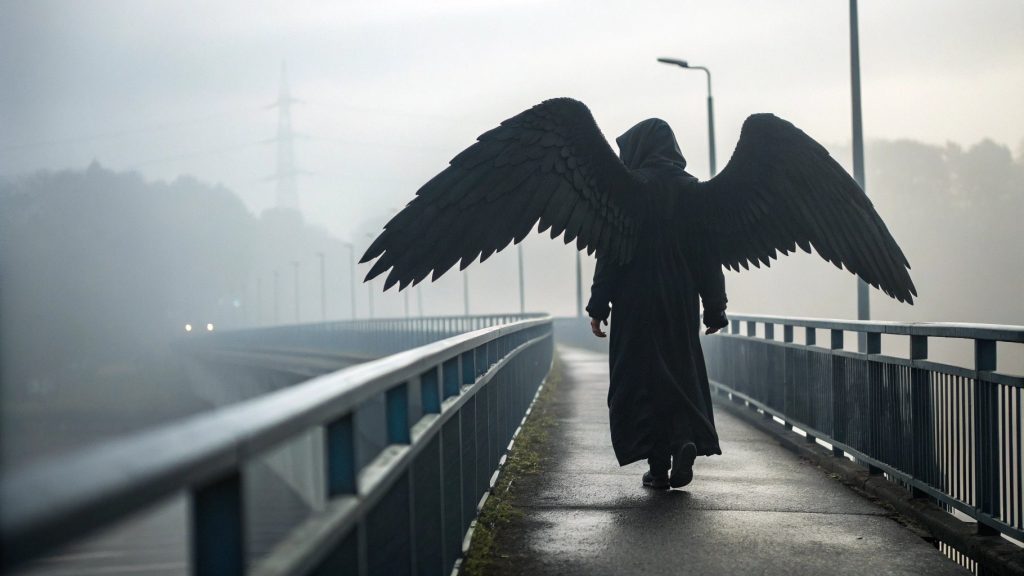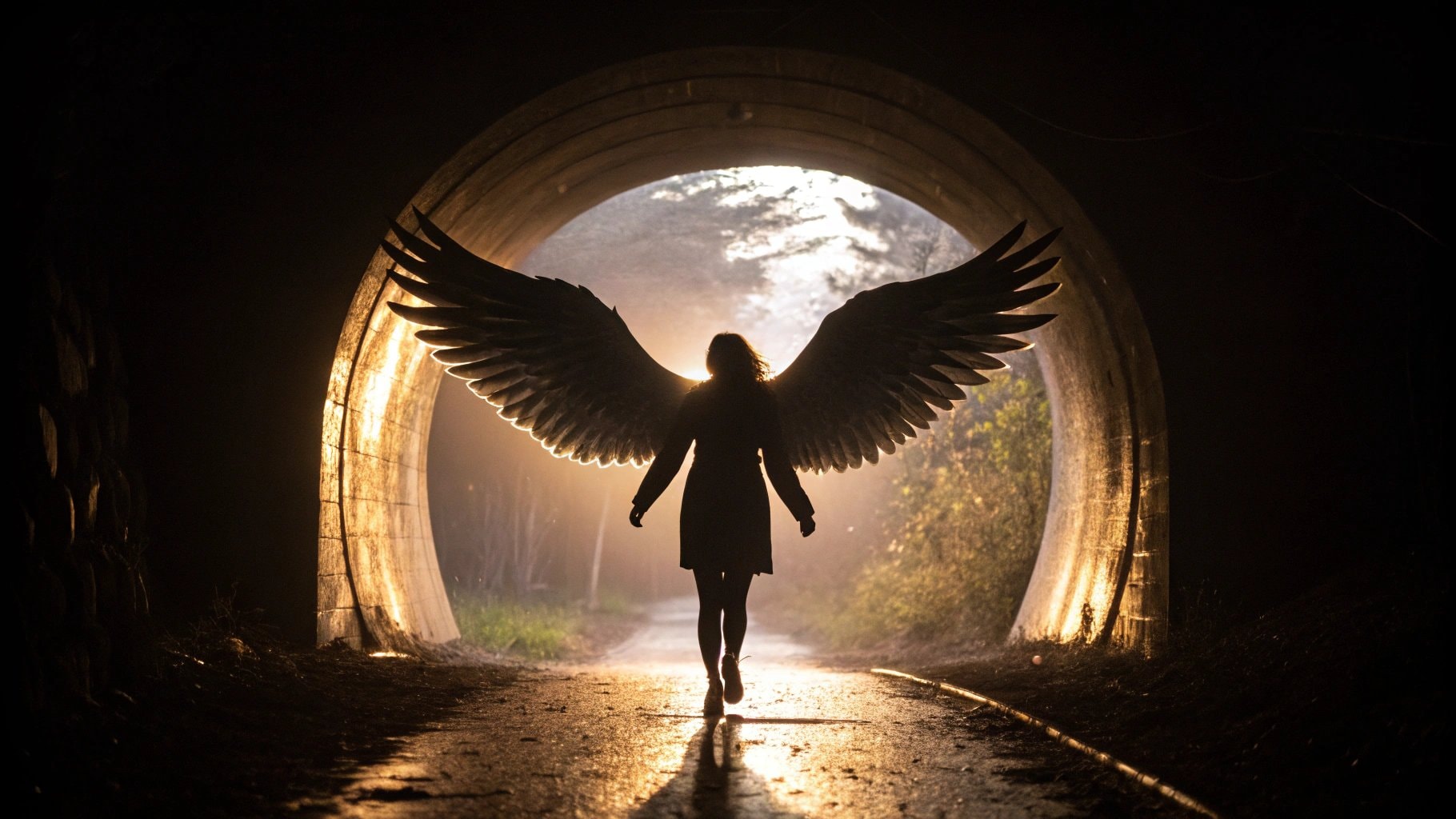Angel of Death in History & Religion: A Cultural Perspective
Olivia Marie Rose | February 20, 2025

- Key Takeaways:
- Who is the Angel of Death? Understanding the Concept
- Azrael: The Angel of Death and His Role Across Religions
- Azrael in Different Religions and Mythologies
- The Symbolism and Appearance of the Angel of Death
- The Angel of Death vs. The Grim Reaper: Are They the Same?
- Common Myths and Misconceptions About Azrael
- Conclusion
- FAQ
Death is one of life’s greatest mysteries, and across cultures and religions, people have created figures to help explain what happens when we pass. One such figure is the Angel of Death, a being believed to guide souls from the physical world to the afterlife. While some fear this entity, others see it as a compassionate guide who ensures a smooth transition for the departed. Azrael, in particular, is often noted for his benevolent role as a psychopomp who ensures the safe passage of souls to the afterlife.
In this blog, we’ll explore the role of the Angel of Death in different religions and cultures, with a special focus on Azrael, the most well-known angel of death. We’ll also break down misconceptions, symbolism, and how this figure appears in mythology and popular culture.
Key Takeaways:
The Angel of Death appears in multiple religions, including Islam, Christianity, and Judaism.
Azrael is the most recognized Angel of Death, primarily in Islam.
The Grim Reaper is a Western adaptation of the Angel of Death.
In different cultures, the Angel of Death can be seen as both a fearsome and a comforting figure.
The concept of the Angel of Death symbolizes the transition from life to the afterlife.
The Angel of Death is often called Azrael in various religious narratives, highlighting his interactions with saints and prophets.
Who is the Angel of Death? Understanding the Concept
The Origin of the Angel of Death
The term “Angel of Death” is not exclusive to one religion or belief system. It is a title given to a spiritual being responsible for guiding souls after death. The idea of an angelic figure overseeing the transition from life to the afterlife is present in Abrahamic religions, mythology, and even modern folklore. Many ancient civilizations also had their own interpretations of death-related deities and spiritual beings who played a role similar to that of Azrael. The Angel of Death operates under God’s power, highlighting His ultimate control over life and death.
Is There Only One Angel of Death?
Many assume that Azrael is the sole Angel of Death, but this is not entirely accurate. In some traditions, multiple angels carry out the duty of collecting souls, each with a distinct purpose. However, Azrael is often seen as the only angel brave enough to descend to Earth and confront the devil, Iblīs, to gather materials for creating mankind, emphasizing his unique role. Some esoteric texts suggest that different angels govern the passing of souls based on moral standing, spiritual growth, or divine judgment, adding layers of complexity to the general understanding of the Angel of Death.
Azrael: The Angel of Death and His Role Across Religions
Azrael in Islamic Teachings
Azrael, known as Malak al-Mawt in Islam, is believed to be the angel entrusted with collecting souls at the time of death. He is neither a force of good nor evil but a divine servant carrying out God’s will. Islamic teachings describe him as meticulously recording the names of the living and erasing them upon their passing. Unlike misconceptions that portray him as a grim executioner, Azrael does not choose who dies—he merely fulfills the command given to him. Azrael proved to be brave enough to descend to Earth before humanity’s creation, facing evil to gather materials for God’s creation of man, which ultimately led to him becoming the angel of death.
Descriptions of Azrael’s appearance vary. Some Islamic traditions depict him as an immense, awe-inspiring figure, while others describe him with countless eyes and tongues, symbolizing his deep awareness of humanity. His role extends beyond collecting souls; he is seen as both a recorder of human deeds and an executor of divine justice, ensuring the transition between life and the afterlife follows the divine order.
Azrael in Christianity and Judaism
Neither Christianity nor Judaism explicitly name Azrael in their sacred texts, but references to an Angel of Death appear across various traditions.
In Christianity, some interpretations suggest that Azrael is among the archangels who help guide souls, though this belief is more common in non-canonical and mystical texts. Christian theology often attributes the role of escorting souls to angels like Michael or Gabriel.
In Judaism, the Angel of Death is sometimes associated with Samael, a complex and often misunderstood figure. While Samael is occasionally depicted as a bringer of death, he also plays a role in divine justice, acting as both a punisher and purifier in certain Kabbalistic traditions.
Both religious perspectives highlight the Angel of Death as more than just a harbinger of mortality—he is a necessary part of the spiritual balance between life, death, and the afterlife.
The True Role of Azrael: More Than Just Death
Azrael is often mischaracterized as a fearsome entity, but religious texts paint a different picture. Rather than being a figure to dread, he is portrayed as a compassionate guide, ensuring a peaceful transition for souls departing from this world.
His responsibilities extend beyond simply collecting souls. He is believed to:
Record the deeds and names of all human beings in the divine ledger.
Escort souls without inflicting harm, acting as a bridge between life and the afterlife.
Provide comfort to the righteous as they approach death, easing their passage.
Maintain cosmic balance, ensuring the divine cycle of life and death functions as intended.
Some traditions even suggest that Azrael mourns human loss, further reinforcing his empathetic nature rather than the emotionless persona often depicted in popular culture.
Azrael in Different Religions and Mythologies
Islam: The Divine Collector of Souls
In Islamic belief, Azrael operates solely under God’s command. He does not act independently, nor does he interfere in human fate. The name Azrael is derived from Hebrew, meaning ‘the one whom God helps’. Some accounts describe a close collaboration between Azrael and other angels, who assist in escorting souls to their final destination—be it eternal peace or divine judgment.
Judaism: The Angel of Death in Jewish Teachings
Jewish teachings reference an angel responsible for death, often identified as Samael. Unlike Azrael, Samael is sometimes portrayed with a more ominous nature. Some mystical traditions describe him as enforcing divine justice, determining the fate of souls based on their earthly deeds.
Christianity: Varying Perspectives on the Angel of Death
Christianity does not have a singular, universally accepted Angel of Death. While some non-canonical texts reference Azrael, mainstream Christian teachings often attribute the guidance of souls to archangels like Michael or Gabriel. These figures are sometimes seen as protectors and escorts for the departed rather than agents of death.
Other Religious and Mythological Parallels
The concept of an entity overseeing death is not exclusive to Abrahamic religions. Many other cultures and mythologies feature similar figures:
Hinduism: Yama, the god of death, presides over the afterlife and determines the fate of souls.
Greek Mythology: Thanatos, the personification of death, ensures a smooth passage to the underworld.
Norse Mythology: Valkyries select fallen warriors and escort them to Valhalla.
Ancient Egyptian and Mesopotamian Beliefs: Various deities and spirits serve as guides between life and the afterlife, overseeing the journey of souls.
The Symbolism and Appearance of the Angel of Death

How is Azrael Depicted?
Descriptions of Azrael vary depending on religious and cultural interpretations. Some believe he appears as a towering figure with countless wings and eyes. Others describe him as a peaceful being dressed in white robes. Some legends depict him as an enormous angel with the ability to assume various forms depending on the person he is visiting. A guided visualization exercise aimed at connecting with Azrael emphasizes the holistic experience of breathing deeply to fill one’s entire body with warmth and comfort, creating a sensory journey that promotes a sense of relaxation and spiritual connectivity.
Symbolic Meaning of the Angel of Death
Wings represent transcendence beyond earthly life. Books or scrolls indicate his duty to record human lives. Black or white robes signify his impartial nature—neither good nor evil. Some religious illustrations depict him holding a vessel or lantern, symbolizing the light that guides souls to their next destination.
The Angel of Death vs. The Grim Reaper: Are They the Same?
The Origins of the Grim Reaper in European Folklore
The Grim Reaper is a figure that emerged from European folklore, particularly during the Black Death in the 14th century. With mass casualties spreading across the continent, people personified death as a skeletal figure in a dark hooded cloak, carrying a scythe to “harvest” souls. The Grim Reaper became an enduring symbol of mortality, appearing in literature, artwork, and religious texts as an ominous force bringing inevitable demise.
Differences Between Azrael and the Grim Reaper
While the Grim Reaper is a folkloric character born from medieval fear and artistic imagination, Azrael is a religious entity with a defined role in divine plans. Here’s how they differ:
| Feature | Azrael (Angel of Death) | Grim Reaper |
|---|---|---|
| Origin | Found in Islamic, Jewish, and Christian traditions | Originated in European folklore |
| Role | Records human lives, guides souls, and follows divine will | Harvests souls arbitrarily, associated with fate |
| Appearance | Varies; sometimes described as having many eyes and wings, sometimes invisible | A skeletal figure with a dark cloak and scythe |
| Moral Alignment | Neutral; neither good nor evil | Often depicted as ominous, though sometimes neutral |
| Depiction in Religion | Considered an archangel following God’s command | Does not belong to religious texts, purely a cultural figure |
Why Some People Confuse the Two?
The confusion between Azrael and the Grim Reaper arises due to their shared association with death. Popular media often blends religious and mythological concepts, similarly portraying death-related figures. Films, books, and TV shows frequently depict the Angel of Death as a hooded figure wielding a scythe, despite religious texts describing Azrael differently. Furthermore, the lack of widespread understanding of religious distinctions leads many to assume that the Grim Reaper is simply another name for Azrael.
Common Myths and Misconceptions About Azrael
Is Azrael a Benevolent or Malevolent Figure?
A major misconception about Azrael is whether he is a force of good or evil. Unlike the Grim Reaper, who is often feared, Azrael is depicted as a neutral divine being. He does not take pleasure in death nor seek to harm people. Instead, he fulfills a duty assigned by God, ensuring souls transition to the afterlife smoothly. While Azrael carries out acts of death, it is ultimately the Lord who remains sovereign over life and death. Some traditions describe him as compassionate, offering comfort to those about to pass.
Does Azrael ‘Take’ Lives or Simply Guide Souls?
Another myth is that Azrael actively causes death. In reality, most religious texts indicate that he does not decide when someone dies but merely carries out the divine will. His role is to retrieve souls at the appointed time, not to inflict harm or punishment. This is a key distinction that separates him from dark entities associated with death in folklore.
Debunking Pop Culture Myths
Modern entertainment has altered public perception of Azrael in several ways:
Movies and TV Shows: Some portray him as a dark, menacing force, similar to the Grim Reaper, which contradicts religious texts.
Books and Comics: Azrael is sometimes depicted as a vengeful angel, seeking to punish the wicked, whereas traditional beliefs do not assign him a punitive role.
Horror and Fantasy Interpretations: Many stories depict the Angel of Death as a terrifying being, whereas religious traditions describe him as impartial and even merciful.
These misrepresentations create fear and misunderstanding, distancing Azrael’s actual role from his portrayal in the media.
Conclusion
Azrael, the Angel of Death, is not a force of fear but a guide entrusted with the soul’s transition from life to the afterlife. Across different religions, he is depicted as a guardian rather than an executioner, fulfilling a divine duty with impartiality and purpose. His presence reflects humanity’s deep curiosity about what happens after death, a question that has shaped spiritual beliefs for centuries. Rather than seeing him as a figure of doom, he can be understood as a silent observer, ensuring that every soul reaches its destined realm in the grand cycle of existence.
FAQ
1. Who is the Angel of Death?
The Angel of Death, often called Azrael, is a spiritual being responsible for guiding souls from the physical world to the afterlife.
2. Is Azrael the same as the Grim Reaper?
No, Azrael is a religious figure in Islamic, Jewish, and Christian traditions, while the Grim Reaper is a folkloric character from European culture.
3. Does Azrael cause death?
Azrael does not cause death; he fulfills God’s command by guiding souls at their appointed time.
4. Is Azrael considered good or evil?
Azrael is neutral, serving as a divine guide without malevolent intent.
5. How is Azrael depicted in religions?
Azrael is described with varying appearances, often as a compassionate and awe-inspiring figure.
Recent Posts

Explore Astrology and Numerology with a Free Online Fortune Teller
Olivia Marie Rose | April 5, 2025

April 10 Zodiac Sign: Embracing the Fiery Spirit of Aries
Aryan K | April 5, 2025

2025 Comprehensive Guide to the Queen of Cups Tarot Card
Aryan K | April 4, 2025

Virgo and Capricorn Compatibility: Understanding Love, Sex, and Friendship
Aryan K | April 4, 2025

November 30 Zodiac: What Being a Sagittarius Means for You
Aryan K | April 4, 2025
Topics
- 4 Digit Angel Numbers
- 5 Digit Angel Numbers
- 6 Digit Angel Numbers
- Astrology and Birth Charts
- Business Astrology
- Career Astrology
- Celebrities and Personalities Astrological Profile
- Children Astrology
- Chinese Astrology
- Different Angel Numbers Meaning
- Double Digit Angel Numbers
- Dreams Interpretation
- Festivals
- Finance Astrology
- Find Baby Names
- Find Best Astrologers
- Gemstones and Birthstones
- Janam Kundli Chart
- Love Astrology
- Marriage Prediction Astrology
- Nakshatra (Constellations)
- Numerology
- Pet Astrology
- Rudraksha Beads
- Single Digit Angel Numbers
- Spirit Animals
- Spirituality and Positivity
- Stars, Planets and Cosmic
- Symbolism
- Tarot Cards
- Triple Digit Angel Numbers
- Understanding Hinduism
- Vastu Shastra
- Vedic Astrology
- Western Astrology
- Yoga and Meditation
- Zodiac Sign Date Calendar
- Zodiac Signs
- Zodiac Signs Compatibility
